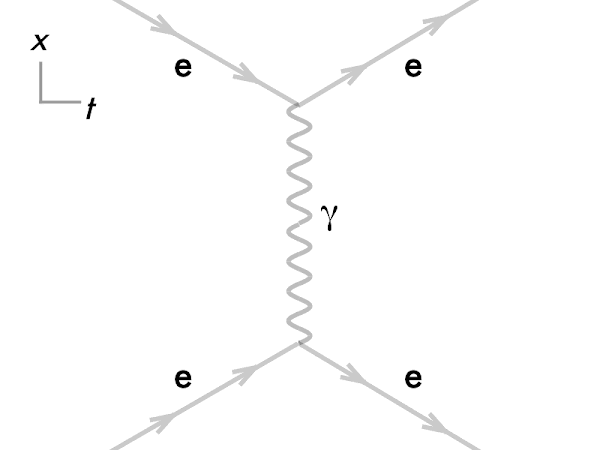Cuesta College, San Luis Obispo, CA
Students have a weekly online reading assignment (hosted by SurveyMonkey.com), where they answer questions based on reading their textbook, material covered in previous lectures, opinion questions, and/or asking (anonymous) questions or making (anonymous) comments. Full credit is given for completing the online reading assignment before next week's lecture, regardless if whether their answers are correct/incorrect. Selected results/questions/comments are addressed by the instructor at the start of the following lecture.
The following questions were asked on reading presentations Feynman diagrams (Phillip "Flip" Tanedo, Cornell University/USLHC Collaboration) and quantum electrodynamics (QED) (Christopher "Bot" Skilbeck, cronodon.com).

Ralph Leighton
symmetrymagazine.org/article/may-2014/saving-the-feynman-van
Selected/edited responses are given below.
Describe what you understand from the assigned textbook reading or presentation preview. Your description (2-3 sentences) should specifically demonstrate your level of understanding.
"We use lines and intersections to draw diagrams that represent particle interactions."
"I am beginning to better understand Feynman diagrams. I understand how time goes and what line is what."
"The decay processes are specific to what each electron is doing. They can all interact with each other in different ways with each process."
"A positively charged proton exchanges photons with a negatively charged electron, producing the Coulomb force of electrostatic attraction. The strong force holds the nucleus together."
"Feynman diagrams are drawings that depict the interactions of electrically charged particles and the virtual proton or photon particles that can be generated. In addition, all of these diagrams must have a particle moving in, a particle being moved out, and a photon being generated or else the electrical particle interaction is not possible."
"If energy is borrow a little amount will last a long time, but a large amount will last a short period of time. As well as the concept of photons, particles, and anti particles."
"In quantum mechanics, forces are attracted by exchanging virtual particles. Virtual means they are measurable by momentum, not mass. The force carriers for nuclear forces are pions. Protons and neutrons are baryons, a type of hadron. Pions are bosons with zero spin."
"I spent most of today reading my chemistry book for a quiz that thankfully is covering the different decay types and electron capture."
"I am really understanding Feynman diagrams. They are quite interesting now."
"The drawing of Feynman diagrams is making more sense now."
"I understand how to draw the diagrams but knowing exactly what they mean is still a little confusing."
Describe what you found confusing from the assigned textbook reading or presentation preview. Your description (2-3 sentences) should specifically identify the concept(s) that you do not understand.
"The reading was pretty heavy material. I anticipate lecture informing us on what we need to know."
"More time spent will clear up a lot of things I think, but right now I am very confused about all the different types of interactions and am looking forward to hearing about them in lecture."
"I'm not sure why we have to use Feynman diagrams to describe these sub-atomic reactions, why not write them out as a chemical reaction like the nuclear decay processes?"
"How to tell if something is positively or negatively charged on a Feynman diagram."
"I think I'm alright for now."
"Still confused with the Feynman diagrams, some of the Greek letters confuse me."
"Just need a general overview in class, this material is a lot and a bit dense for sure."
"I am confused when I try to interpret the diagrams. I understand the ABC (always balance charges) and CBA (cancellation by annihilation) rules along with the validity of each (1 line in/out, 1 squiggly). I do not understand how to interpret the diagram themselves. I do also understand that time moves left-to-right. Everything, so sorry."

negative. **** [4] zero. ********* [9] positive. ******** [8] (Unsure/guessing/lost/help!) *** [3]

negative. ******** [8] zero. *** [3] positive. ********** [10] (Unsure/guessing/lost/help!) *** [3]

negative. ** [2] zero. ********** [10] positive. ******* [7] (Unsure/guessing/lost/help!) ***** [5]
The (valid) Feynman diagram in the previous question above depicts a(n) __________ decay process.
α. * [1] β+. ********* [9] β–. ***** [5] electron capture. **** [4] γ. * [1] (Unsure/guessing/lost/help!) **** [4]
Ask the instructor an anonymous question, or make a comment. Selected questions/comments may be discussed in class.
"For antimatter, do paths always travel reversed (right-to-left) with respect to time?" (Yes, that's the convention we're using with these Feynman diagrams, although antimatter doesn't literally go backwards in time.)
"I really want to understand every single lessons that we did (even though I do okay in general) before learning new contents... It really bothers me to be so slow to understand the concepts."
"Please go over examples above."
No comments:
Post a Comment